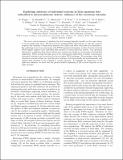Files in this item
Exploring coherence of individual excitons in InAs quantum dots embedded in natural photonic defects : influence of the excitation intensity
Item metadata
| dc.contributor.author | Wigger, D. | |
| dc.contributor.author | Mermillod, Q. | |
| dc.contributor.author | Jakubczyk, T. | |
| dc.contributor.author | Fras, F. | |
| dc.contributor.author | Le-Denmat, S. | |
| dc.contributor.author | Reiter, D. E. | |
| dc.contributor.author | Höfling, Sven | |
| dc.contributor.author | Kamp, M. | |
| dc.contributor.author | Nogues, G. | |
| dc.contributor.author | Schneider, C. | |
| dc.contributor.author | Kuhn, T. | |
| dc.contributor.author | Kasprzak, J. | |
| dc.date.accessioned | 2017-10-26T10:30:55Z | |
| dc.date.available | 2017-10-26T10:30:55Z | |
| dc.date.issued | 2017-10-24 | |
| dc.identifier | 251316692 | |
| dc.identifier | 1c52ec7d-cac7-4186-b80e-beb5e2104353 | |
| dc.identifier | 85038099527 | |
| dc.identifier | 000413510900004 | |
| dc.identifier.citation | Wigger , D , Mermillod , Q , Jakubczyk , T , Fras , F , Le-Denmat , S , Reiter , D E , Höfling , S , Kamp , M , Nogues , G , Schneider , C , Kuhn , T & Kasprzak , J 2017 , ' Exploring coherence of individual excitons in InAs quantum dots embedded in natural photonic defects : influence of the excitation intensity ' , Physical Review. B, Condensed matter and materials physics , vol. 96 , no. 16 , 165311 . https://doi.org/10.1103/PhysRevB.96.165311 | en |
| dc.identifier.issn | 1098-0121 | |
| dc.identifier.uri | https://hdl.handle.net/10023/11925 | |
| dc.description | We acknowledge the financial support by the European Research Council (ERC) Starting Grant PICSEN (grant no. 306387) | en |
| dc.description.abstract | The exact optical response of quantum few-level systems depends crucially on the exact choice of the incoming pulse areas. We use four-wave mixing (FWM) spectroscopy to infer the coherent response and dynamics of single InAs quantum dots (QDs) and study their pulse area dependence. By combining atomic force microscopy with FWM hyperspectral imaging, we show that the retrieved FWM signals originate from individual QDs enclosed in natural photonic defects. The optimized light-matter coupling in these defects allows us to perform our studies in a wide range of driving field amplitudes. When varying the pulse areas of the exciting laser pulses Rabi rotations of microscopic interband coherences can be resolved by the two-pulse FWM technique. We investigate these Rabi coherence rotations within two- and three-level systems, both theoretically and experimentally, and explain their damping by the coupling to acoustic phonons. To highlight the importance of the pulse area in uence, we show that the phonon-induced dephasing of QD excitons depends on the pulse intensity. | |
| dc.format.extent | 12 | |
| dc.format.extent | 2364697 | |
| dc.language.iso | eng | |
| dc.relation.ispartof | Physical Review. B, Condensed matter and materials physics | en |
| dc.subject | QC Physics | en |
| dc.subject | NDAS | en |
| dc.subject.lcc | QC | en |
| dc.title | Exploring coherence of individual excitons in InAs quantum dots embedded in natural photonic defects : influence of the excitation intensity | en |
| dc.type | Journal article | en |
| dc.contributor.institution | University of St Andrews. School of Physics and Astronomy | en |
| dc.contributor.institution | University of St Andrews. Condensed Matter Physics | en |
| dc.identifier.doi | 10.1103/PhysRevB.96.165311 | |
| dc.description.status | Peer reviewed | en |
| dc.identifier.url | https://journals.aps.org/prb/supplemental/10.1103/PhysRevB.96.165311 | en |
This item appears in the following Collection(s)
Items in the St Andrews Research Repository are protected by copyright, with all rights reserved, unless otherwise indicated.

